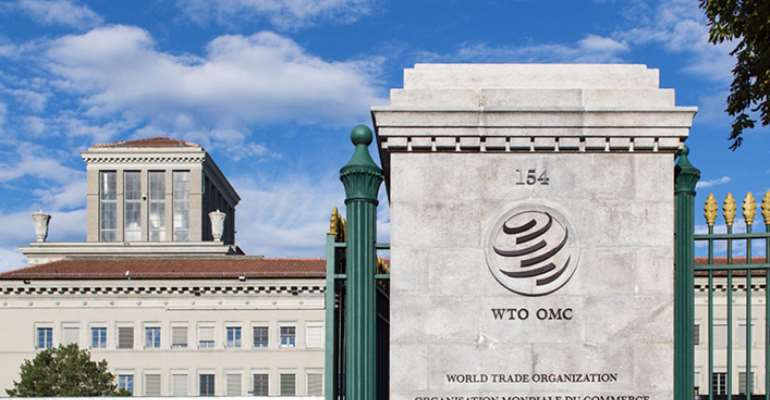Global Trade Increase To $30tn In 2023, Says WTO

The World Trade Organisation disclosed that Global trade has continued to grow, reaching over US$ 30.4 trillion in 2023, a fivefold increase since 1995.
In a report to mark its 30th anniversary, the WTO, which was established on April 15, 1994, after the signing of the Marrakesh Agreement, explained that between 1995 and 2023, total world trade in goods and commercial services surged, averaging 5.8 per cent per year.
According to the report, “Notably, trade in commercial services outpaced goods trade, with an average annual increase of 6.8 per cent, compared to 5.5 per cent for goods.
“The growth of world trade outpaced that of global gross domestic product, which increased by an average of 4.4 per cent per year over the same period. The global trade-to-GDP ratio showed a significant upward trajectory, rising from 20 per cent in 1995 to 31 per cent in 2022, before falling back to 29 per cent in 2023, as goods trade declined in value terms on a balance-of-payments basis."
The report also noted that the trade growth has coincided with a significant decrease in poverty worldwide, indicating the impact of trade on supporting economic development and improving people’s lives.
It said, “The 30 years since the WTO’s creation have ushered in a new era of trade and economic growth.
“This indicates the growing interconnectedness of economies through trade, despite temporary declines during the global financial crisis of 2008-09 and the COVID-19 pandemic in 2020.
“The share of services in trade — particularly digitally delivered services — is growing
The past three decades have also witnessed a growing share of services in global trade.”
The WTO was launched 30 years ago to succeed the General Agreement on Tariffs and Trade (GATT), which mainly dealt with trade in goods.
WTO economists have projected that the volume of world merchandise trade should increase by 2.6 per cent in 2024 and 3.3 per cent in 2025 after falling 1.2 per cent in 2023.
WTO Director-General Ngozi Okonjo-Iweala noted that, “We are making progress towards global trade recovery, thanks to resilient supply chains and a solid multilateral trading framework — which are vital for improving livelihoods and welfare. It’s imperative that we mitigate risks like geopolitical strife and trade fragmentation to maintain economic growth and stability.”
The report showed that, “According to the WTO’s latest estimates, recently presented in the Global Trade Outlook and Statistics, with the inclusion of mode 3 services trade, the services share of global trade in 2022 was close to 42 per cent.
“WTO estimates also show that digitally delivered services have experienced a fourfold increase in value since 2005, with an average annual growth rate of 8.2 per cent over the period 2005-23. This growth has outpaced that of goods (4.8 per cent) and other services exports (4.6 per cent).
“Global exports of digitally delivered services soared to US$ 4.25tn in 2023, up 9.0 per cent year-on-year. Digital delivery includes services traded across borders via computer networks (through the internet, mobile apps, emails, voice and video calls), and, increasingly, through digital intermediation platforms (such as those used for online gaming, music and video streaming, and remote learning)."
It further indicated that between 1995 and 2020, international trade costs — including all physical and regulatory trade barriers — decreased by approximately 6 to 10 per cent across various sectors globally.
It said, “Over the past three decades, the rapid economic growth facilitated by trade in developing and emerging economies has significantly transformed trade patterns, with particular growth in global trade between developing economies.
“Trade between developing economies expanded at a rate of 9.7 per cent per year, surging from less than a tenth of global trade in 1995 to nearly 25 per cent by 2022, reaching a total value of US$ 6.1 trillion."
WTO also expressed that while trade between developed economies accounted for over half of global trade in 1995, by 2022 this proportion had declined to 39 per cent, confirming a relative shift in trade flows towards developing and emerging economies.
It said, “In 2022, the total GVC participation rate (comprising both forward and backward participation) reached 48.7 per cent, marking the highest level since 1995.
“There has been a clear downward trend in tariffs since the WTO was established in 1995.
“Between 1996 and 2022, the trade-weighted average of applied tariffs — based on the assumption of full utilisation of preferential tariffs — dropped from 6.9 per cent to 2.0 per cent."
Recently, the trade organisation revealed that global goods trade is expected to pick up gradually this year following a contraction in 2023, driven by the lingering effects of high energy prices and inflation.
